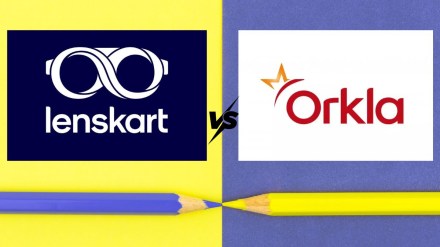Two well-known consumer brands are opening their IPO this week. One is an eyewear retailer. Lenskart and the other a food major. Orkla India (formerly MTR Foods) heading to Dalal Street with their public offering.
Here’s a look at how the two stack up and which one could be a more attractive bet for investors.
Lenskart IPO Vs Orkla IPO: Timeline and price band
Lenskart’s IPO will open for subscription on October 31 and close on November 4, with a price band of Rs 382–402 per share. The company is planning to raise Rs 7,278.02 crore through this offering. It includes a fresh equity raise of Rs 2,150 crore and an offer-for-sale (OFS) of over 12.75 crore shares by promoters and investors. Shares are expected to list on November 10.
Meanwhile, Orkla India’s IPO, the parent firm for MTR, will hit the market slightly earlier, opening on October 29 and closing on October 31, with a price band of Rs 695–730 per share. This issue is entirely an OFS of 2.28 crore shares, meaning the company itself won’t receive any proceeds. The listing is likely on November 6.
Lenskart IPO Vs Orkla IPO: Offer structure and investor quota
Lenskart’s offer has a higher institutional focus, with 75% reserved for QIBs, 15% for NIIs, and 10% for retail investors. A discount of Rs 19 per share has been offered to eligible employees.
In contrast, Orkla India’s IPO follows a more balanced split. 50% for QIBs, 15% for NIIs, and 35% for retail investors with 30,000 shares set aside for employees.
Lenskart IPO Vs Orkla IPO: Overview of the company
Founded in 2008, Lenskart has grown into India’s largest omni-channel eyewear retailer. The company sells prescription glasses, sunglasses, as well as contact lenses through both online and offline stores across India and abroad. This company is backed by investors such as SoftBank and Radhakishan Damani.
On the other side, Orkla India, the Indian arm of Norwegian conglomerate Orkla ASA operates in the packaged food segment, marketing products under well-known brands MTR, Eastern, and Rasoi Magic.
It offers spices, ready meals, breakfast mixes, and sweets. With no fresh issue component, the IPO is primarily an exit route for its promoters and existing shareholders.
Lenskart IPO Vs Orkla IPO: Fund utilisation
Lenskart’s IPO will bring in fresh funds to support expansion, improve tech infrastructure, and enhance brand visibility. In addition to this, the company plans to use IPO proceeds to expand company-owned stores, strengthen its tech and supply chain systems, and invest in marketing and acquisitions.
Orkla India’s issue, however, is purely an OFS, meaning investors will not see fresh capital being infused into the company.
Lenskart IPO Vs Orkla IPO: The expert take
Here are some expert views on the Lenskart and Orkla India IPO by SBI Securities. According to the Research House, Orkla India has been one of the top four companies in terms of revenues among select leading spices and convenience food peers as of FY24. It has a wide product range of 400 products across categories. They pointed out that “it is a virtually debt-free company, makes healthy return ratios & margins and generates stable cash flows of Rs 300-400 cr annually. At the upper price band of Rs 730, it is valued at FY25 PE of 34.6x on post-issue capital.” Looking at the historical growth, SBI Securities believes that the “issue looks fairly valued. Hence, we maintain a ‘Neutral’ view on the issue and would like to monitor the performance of the company post listing.”
In comparison, several analysts have raised concerns about whether the Lenskart IPO is priced too high. According to Sunny Agrawal – Head of Fundamental Research, SBI Securities, “On the valuation, at the upper end of the price band, the issue represents a market cap of Rs 70,000 crore. At 10x EV/Sales multiple, valuations are stretched from a medium-term perspective. No doubt the business model is fairly strong; the company has made solid on-ground progress. However, at the current price, it is ideal for those looking at long-term plays in the retail eyewear manufacturing-to-consumer platform. Going forward, the key metrics to track will be the ability of the business to scale its profitability inline with its international peers.”
